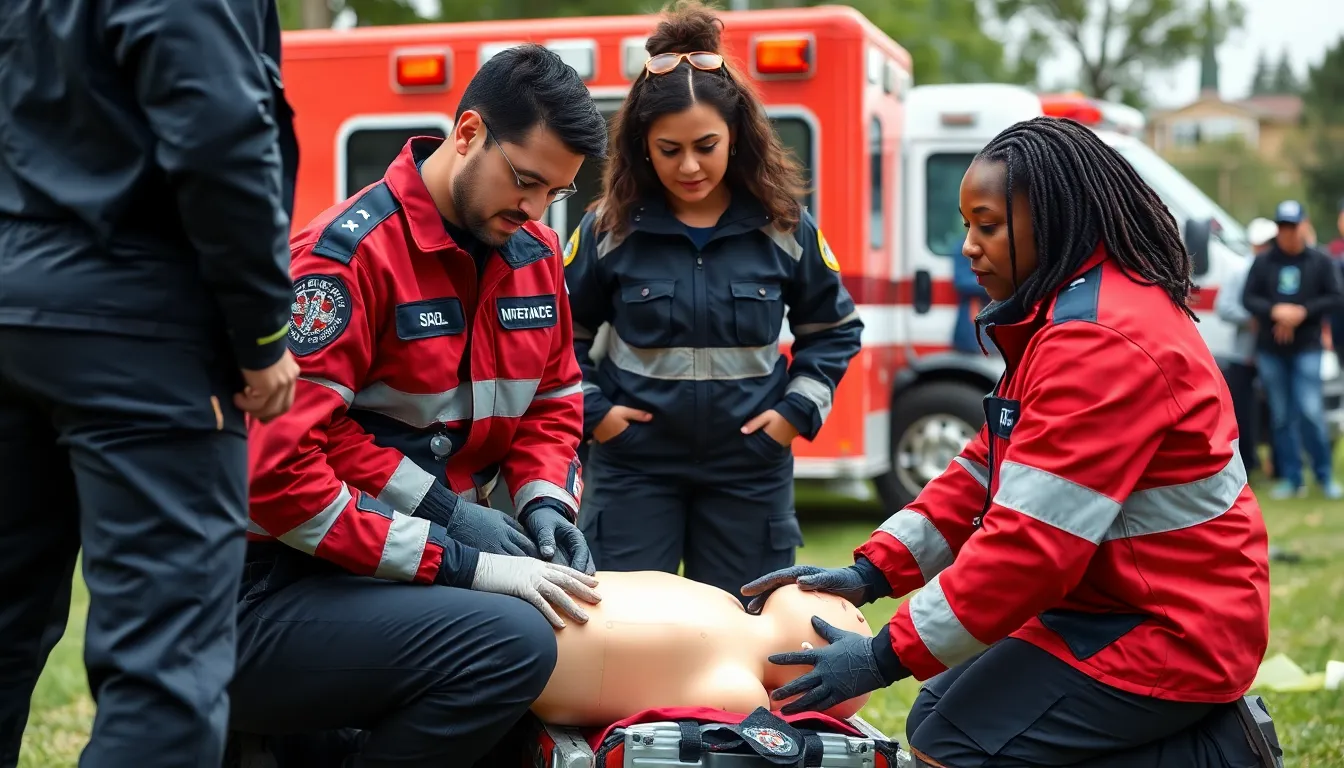In the world of emergency medical services, few texts are as impactful as Nancy Caroline’s “Emergency Care in the Streets.” This book isn’t just a manual; it’s a lifeline for paramedics navigating the chaos of emergency situations. With its blend of humor and hard-hitting facts, it transforms the daunting task of saving lives into a manageable—and sometimes even entertaining—adventure.
Imagine being on the front lines, adrenaline pumping, and suddenly realizing you’ve got a mini medical library at your fingertips. Nancy Caroline’s work provides the essential knowledge and skills to tackle any emergency, all while keeping a smile on your face. Whether you’re a seasoned pro or just starting your journey in EMS, this guide is your trusty sidekick, ready to help you conquer the streets with confidence and a dash of wit.
Table of Contents
ToggleOverview of Nancy Caroline Emergency Care in the Streets
Nancy Caroline’s “Emergency Care in the Streets” serves as an essential guide within the emergency medical services landscape. This book combines practical knowledge with engaging content, making it invaluable for both experienced paramedics and those new to the field. Comprehensive information on emergency care protocols ensures readers grasp critical concepts and procedures.
Paramedics benefit from its structured format, which emphasizes core principles of prehospital care. Detailed illustrations provide visual support for complex topics, enhancing understanding. The book addresses real-world scenarios, equipping responders to manage various emergencies confidently.
Critical areas covered include trauma assessment, airway management, and cardiac emergencies. These sections detail step-by-step approaches, ensuring clarity in high-pressure situations. Each chapter integrates case studies that illustrate the application of learned skills, promoting practical learning.
The engaging tone helps alleviate the gravity often associated with emergency response, offering humorous anecdotes to maintain reader interest. Personal stories contribute depth, bridging theory with practice in a relatable manner. The adaptability of the material supports the diverse backgrounds of paramedics.
Rich in content, “Emergency Care in the Streets” also outlines legal considerations, ethics, and communication techniques crucial for effective teamwork. As a comprehensive resource, it prepares individuals not just for emergencies, but also for the emotional resilience required in the field. This book remains a cornerstone of paramedic education, shaping the future of emergency medical services and fostering best practices in emergency care.
Key Concepts and Principles

This section outlines essential principles from Nancy Caroline’s “Emergency Care in the Streets.” It emphasizes key areas critical to effective prehospital care.
Patient Assessment
Patient assessment serves as a fundamental skill for emergency responders. First, thorough history-taking aids in understanding the patient’s condition. Second, a systematic approach to physical examinations identifies any immediate threats. Third, vital signs provide crucial data to gauge the severity of situations. Additionally, utilizing tools like the Glasgow Coma Scale assists in evaluating neurological status. Importantly, responders should consider the mechanism of injury or nature of illness, as this context influences treatment decisions. By combining objective findings with patient input, practitioners enhance diagnostic accuracy in high-pressure environments.
Medical Interventions
Medical interventions focus on providing timely and appropriate care in emergencies. They include airway management techniques like intubation or the use of bag-valve-mask devices. Rapid assessment guides the choice of interventions during cardiac emergencies, where defibrillation may be necessary. Additionally, responders employ intravenous access to administer medications promptly. Techniques for managing trauma include splinting fractures and controlling hemorrhage through direct pressure. Knowledge of pharmacology enables responders to use medications effectively, such as administering epinephrine for anaphylaxis. Ultimately, understanding treatment protocols helps providers stabilize patients and optimize outcomes in dynamic situations.
The Role of EMS Providers
Emergency Medical Services (EMS) providers play a crucial role in prehospital care. They respond to emergencies, offering critical interventions that can save lives.
Importance of Training
Training equips EMS providers with essential skills and knowledge. Structured programs in emergency care allow providers to understand complex medical scenarios. Simulation-based training enhances decision-making under pressure. Continuous education fosters familiarity with evolving protocols and technologies. This commitment to improvement ensures consistent, high-quality care for patients.
Emotional Resilience
Emotional resilience is vital for EMS providers as they encounter traumatic and high-stress situations. It influences their ability to maintain composure while delivering urgent care. Support systems, such as peer discussions and counseling, help manage stress. Building resilience through training prepares providers for the realities of emergency response. Cultivating this aspect not only aids personal well-being but also enhances overall team dynamics in critical incidents.
Case Studies and Real-World Applications
“Emergency Care in the Streets” incorporates numerous real-world scenarios to enhance practical learning for paramedics. Each case study highlights specific challenges responders face, illustrating how foundational principles apply in varied situations. For instance, scenarios involving trauma assessment cover critical decision-making processes, guiding practitioners through the complexities of patient management.
In a notable urban emergency, a paramedic team utilized skills from the book to assess a multi-trauma patient efficiently. Recognizing life-threatening injuries expedited their intervention, showcasing the significance of rapid assessment techniques. This example underscores the importance of systematic approaches and reinforces the structured learning embedded in the text.
Another case revolves around cardiac emergencies, where accurate history-taking played a crucial role. Analyzing patient responses led to swift treatment decisions, emphasizing the value of thorough assessments. Effective communication among team members enabled coherent patient management, demonstrating how collaborative efforts can save lives in high-pressure situations.
In rural settings, a paramedic faced a severe allergic reaction. Knowledge from the book regarding pharmacology guided the administration of epinephrine. The prompt response not only stabilized the patient but also illustrated how essential protocol adherence is in real-life applications.
Additionally, the book touches on legal and ethical considerations during emergencies. A case study involving a consent issue sheds light on challenges EMS providers frequently encounter. Navigating these complexities highlights the necessity for solid foundational knowledge in all aspects of emergency care, crucial for developing effective responders.
Overall, case studies within “Emergency Care in the Streets” bridge theory with practical application, equipping paramedics with the skills to handle diverse emergencies confidently.
Nancy Caroline’s “Emergency Care in the Streets” stands as a transformative resource in the realm of emergency medical services. Its blend of humor and essential knowledge makes it accessible for both seasoned paramedics and newcomers. The structured format and real-world case studies foster a deeper understanding of critical concepts, enabling responders to navigate emergencies with confidence.
Moreover, the book emphasizes the importance of emotional resilience and teamwork, equipping EMS providers with the tools needed to thrive in high-pressure situations. By bridging theory with practical application, it not only enhances individual skills but also elevates the standards of emergency care as a whole. This vital resource continues to shape the future of paramedic education and practice, ensuring that those who serve on the front lines are well-prepared for the challenges they face.



